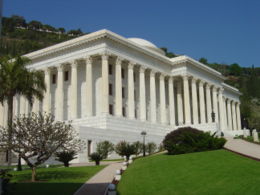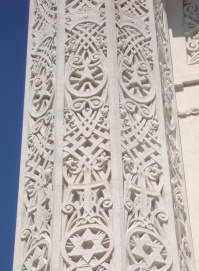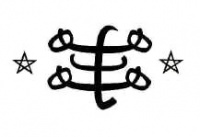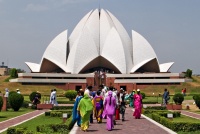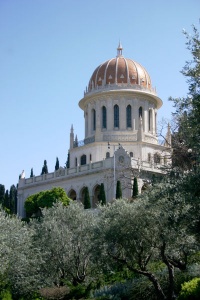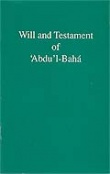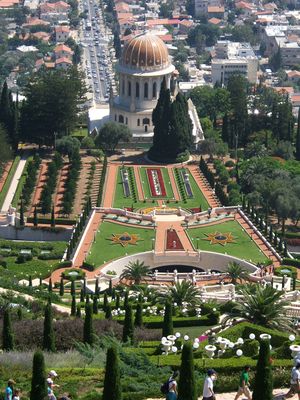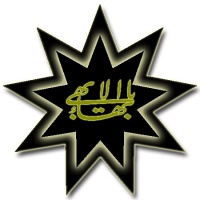Baha'i
The Bahá'í Faith is a religion founded by Bahá'u'lláh in 19th century Persia. There are around six million Bahá'ís in more than 200 countries around the world.[1][2]
According to Bahá'í teachings, religious history is seen as an evolving educational process for mankind, through God's messengers, which are termed Manifestations of God. Bahá'u'lláh is seen as the most recent, pivotal, but not final of these individuals. He claimed to be the expected redeemer and teacher prophesied in Christianity, Islam, , Buddhism and other religions and that his mission was to establish a firm basis for unity throughout the world, and inaugurate an age of peace and justice, which Bahá'ís expect will inevitably arise.[3]
"Bahá'í" (/baˈhaːʔiː/) can be an adjective referring to the Bahá'í Faith, or the term for a follower of Bahá'u'lláh (Bahá'í is not a noun meaning the religion as a whole). The term comes from the Arabic word Bahá’ (بهاء), meaning "glory" or "splendour".[4]
Contents
Beliefs
Three core principles of Bahá'í teachings are often referred to simply as: the , the , and the .[2] Many Bahá'í beliefs and practices are rooted in these priorities; but taken alone these would be an over-simplification of Bahá'í teachings.
God
Bahá'ís believe in a single, imperishable , the creator of all things, including all the creatures and forces in the universe.[5] The existence of God is thought to be eternal, without a beginning or end,[5] and is described as "a personal God, unknowable, inaccessible, the source of all Revelation, eternal, omniscient, omnipresent and almighty."[6] Though inaccessible directly, God is nevertheless seen as conscious of his creation, with a will and purpose. Bahá'ís believe that God expresses this will in many ways, including through a series of divine messengers referred to as or sometimes divine educators.[2] In expressing God's intent, these manifestations are seen to establish religion in the world.
Bahá'í teachings state that God is too great for humans to fully comprehend, or to create a complete and accurate image.[7] In the Bahá'í religion God is often referred to by titles (e.g. the All-Powerful, or the All-Loving), and there is a substantial emphasis on , as well as a rejection of such doctrines as the .[8][9]
Religion
Bahá'í notions of progressive religious revelation result in their accepting the validity of most of the worlds' religions, whose founders and central figures are seen as Manifestations of God. Religious history is interpreted as a series of , where each manifestation brings a somewhat broader and more advanced , suited for the time and place in which it was expressed.[5] Specific religious social teachings (e.g. the direction of prayer, or dietary restrictions) may be revoked by a subsequent manifestation so that a more appropriate requirement for the time and place may be established. Conversely, certain general principles (e.g. neighbourliness, or charity) are seen to be universal and consistent. Bahá'ís do not believe that this process of progressive revelation will end. They do, however, believe that it is cyclical. Bahá'ís do not expect a new manifestation of God to appear prior to 1000 years after Bahá'u'lláh's revelation.[10][11]
Bahá'í beliefs are sometimes described as combinations of earlier religions' beliefs. Bahá'ís, however, assert that their religion is a distinct tradition with its own scriptures, teachings, laws, and history.[5] Its cultural and religious debt to the ic matrix in which it was founded is seen as analogous to the Jewish socio-religious context in which Christianity was established. Bahá'ís describe their faith as an independent world religion, differing from the other traditions only in its relative newness and in the appropriateness of Bahá'u'lláh's teachings to the modern context. Bahá'u'lláh is believed to fulfill the of these precursor faiths.
Human beings
Bahá'ís believe that human beings have a "rational ", and that this provides the species with a unique capacity to recognize God's station and humanity's relationship with its creator. Every human is seen to have a duty to recognize God through his , and to conform to their teachings.[12] Through recognition and obedience, service to humanity and regular prayer and spiritual practice, Bahá'ís believe that the soul becomes closer to God, the spiritual ideal in Bahá'í belief. When a human dies, the soul passes into the next world, where its spiritual development in the physical world becomes a basis for judgment and advancement in the spiritual world.[13] Heaven and Hell are taught to be spiritual states of nearness or distance from God that describe relationships in this world and the next, and not physical places of reward and punishment achieved after death.[13]
The Bahá'í writings emphasize the essential equality of human beings, and the abolition of prejudice. Humanity is seen as essentially one, though highly varied; its diversity of race and culture are seen as worthy of appreciation and tolerance.[2] Doctrines of racism, nationalism, caste and social class are seen as artificial impediments to unity.[2] The Bahá'í teachings state that the unification of mankind is the paramount issue in the religious and political conditions of the present world.[5]
Demographics
Bahá'í sources usually estimate the worldwide Bahá'í population to be above 5 million.[14] Encyclopedias and similar sources estimate from 2 to 8 million Bahá'ís in the world in the early twenty-first century, with most estimates between 5 and 6 million.[15][16][17][18]
From its origins in the and Empires, the Bahá'í Faith had acquired a number of converts by . Fifty years later its population has spread throughout the world as a result of efforts.
According to The World Almanac and Book of Facts 2004: Template:Cquote
The Bahá'í religion was listed in The Britannica Book of the Year (1992–present) as the second most widespread of the world's independent religions in terms of the number of countries represented. Britannica claims that it is established in 247 countries and territories; represents over 2,100 ethnic, racial, and tribal groups; has scriptures translated into over 800 languages; and has seven million adherents worldwide [2005].[15]
Teachings
Summary
, the appointed head of the religion from 1921 to 1957, wrote the following summary of what he considered to be the distinguishing principles of 's teachings, which, he said, together with the laws and ordinances of the ' constitute the bed-rock of the Bahá'í Faith: Template:Cquote
Social principles
The following 12 principles are frequently listed as a quick summary of the Bahá'í teachings. They are derived from transcripts of speeches given by during his tour of Europe and North America in 1912.[19] The list is not authoritative and a variety of such lists circulate.[19][20]
- Independent investigation of truth
- Obedience to government and non-involvement in partisan politics
- Elimination of extremes of wealth and poverty
Mystical teachings
Although it concentrates on social and ethical issues as well, some of the Bahá'í Faith's foundational texts might be described as mystical.[5] Shoghi Effendi has called the ' Bahá'u'lláh's "greatest mystical composition." It was written to a follower of , a mystic and esoterical tradition of Islam.[21] It was first translated into English in 1906, becoming one of the earliest available books of Bahá'u'lláh to the . The ' is another book written by Bahá'u'lláh during the same period, containing 153 short passages described by `Abdu'l-Bahá as "a treasury of divine mysteries".
The Covenant
Bahá'ís have high regard for what is termed the "Greater Covenant", which they see as universal in nature, and from "time immemorial" has been carried through by the of all ages.[22] They also regard highly the "Lesser Covenant", which is viewed as an agreement between a Messenger of God and his followers, unique to each revelation, and includes social practices and the continuation of authority in the religion.[23] At this time Bahá'ís view Bahá'u'lláh's revelation as a binding lesser covenant for his followers; in the Bahá'í writings being firm in the covenant is considered as one of the main religious virtues a person can work toward.[23]
With unity as an essential teaching of the religion, Bahá'ís follow an that they believe is divinely ordained, and therefore see attempts to create schisms and divisions as insignificant, doomed efforts which are contrary to the teachings of Bahá'u'lláh. Throughout Bahá'í history schisms have occurred over the succession of authority.[23] The followers of the various , who in total, number in the low thousands, are regarded as s and shunned,[23] essentially .
History
Bahá'í history is often traced through a sequence of leaders, beginning with the 's 1844 declaration in Shiraz, and ultimately resting on an administrative order established by the central figures of the religion. The tradition was mostly isolated to the and empires until after the death of Bahá'u'lláh in 1892, at which time he had followers in thirteen countries of Asia and Africa.[24] Under the leadership of his son, `Abdu'l-Bahá, the religion gained a footing in Europe and America, and was consolidated in Iran, where it still suffered intense .[25] After the death of `Abdu'l-Bahá in 1921, the leadership of the Bahá'í community entered a new phase, evolving from that of a single individual to an administrative order with a system of both elected bodies and appointed individuals.
The Báb
In 1844 Siyyid `Alí-Muhammad of proclaimed that he was "the Báb" (Template:ArB "the Gate"), after a religious concept.[25] His followers were therefore known as . As the Báb's teachings spread, which the Islamic clergy saw as a threat, Bábís came under increased persecution, at times being forced to choose between renouncing their beliefs or being killed.[5] Several military confrontations took place between government and Bábí forces. The Báb himself was imprisoned and eventually executed in 1850.[26]
Bahá'ís see the Báb as the forerunner of the Bahá'í Faith, because the Báb's writings introduced the concept of "", a Messianic figure whose coming, according to Bahá'ís, was announced in the scriptures of all of the world's great religions, and whom Bahá'u'lláh, the founder of the Bahá'í Faith, claimed to be in 1863.[5] is located in , and is an important place of for Bahá'ís. The remains of the Báb were brought secretly from Persia to the Holy Land and were eventually interred in the Shrine built for them in a spot specifically designated by Bahá'u'lláh.[27]
Bahá'u'lláh
Mírzá Husayn `Alí of Núr was one of the early followers of the Báb, who later took the title of Bahá'u'lláh. He was arrested and imprisoned for this involvement in 1852. He claimed that while incarcerated in the dungeon of the in , he received the first intimations that he was the one anticipated by the Báb.[2] He announced this in 1863.
Shortly thereafter he was expelled from to ,[2] in the ; then to Constantinople (now ); and then to Adrianople (now ). During this time tensions grew between Bahá'u'lláh and , the appointed leader of the Bábís, culminating in Bahá'u'lláh's 1866 declaration.[28] While in Adrianople, he wrote letters to several rulers of the world, including Sultan , declaring his mission as a Messenger of God. As a result Bahá'u'lláh was banished a final time, to the penal colony of `Akká. (Now , in present-day .)[28]
Towards the end of his life, the strict and harsh confinement was gradually relaxed, and he was allowed to live in a home near `Akká, while still officially a prisoner of that city.[28] He died there in 1892. Bahá'ís regard his resting place at as the to which they turn in prayer each day. During his lifetime, Bahá'u'lláh left a large volume of . The (The Most Holy Book), and the (The Book of Certitude) are recognized as major theological works, and the ' and the ' as mystical treatises.
`Abdu'l-Bahá
`Abbás Effendi was Bahá'u'lláh's eldest son, known by the title of `Abdu'l-Bahá (Servant of Bahá). His father left a that appointed `Abdu'l-Bahá as the leader of the Bahá'í community, and designated him as the "Centre of the Covenant", "Head of the Faith", and the sole authoritative interpreter of Bahá'u'lláh's writings.[29][27]
`Abdu'l-Bahá had shared his father's long exile and imprisonment, which continued until `Abdu'l-Bahá's own release as a result of the in 1908. Following his release he led a life of travelling, speaking, teaching, and maintaining correspondence with communities of believers and individuals, expounding the principles of the Bahá'í Faith.[2]
Bahá'í administration
Bahá'u'lláh's ' and The are foundation documents of the Bahá'í administrative order. Bahá'u'lláh established the elected , and `Abdu'l-Bahá established the appointed hereditary Guardianship and clarified the relationship between the two institutions.[27] In his Will, `Abdu'l-Bahá appointed his eldest grandson, , as the first Guardian of the Bahá'í Faith.[3]
Shoghi Effendi throughout his lifetime translated ; developed global plans for the expansion of the Bahá'í community; developed the ; carried on a voluminous correspondence with communities and individuals around the world; and built the administrative structure of the religion, preparing the community for the election of the Universal House of Justice.[2] He died in 1957 under conditions that didn't allow for a successor to be appointed.
At local, regional, and national levels, Bahá'ís elect members to nine-person , which run the affairs of the religion.[5] There are also working at various levels, including locally and internationally, which perform the function of propagating the teachings and protecting the community.[5] The latter do not serve as , which the Bahá'í Faith does not have.[5]
The Universal House of Justice, first elected in 1963, remains the supreme governing body of the Bahá'í Faith, and its 9 members are elected every five years by the members of all National Spiritual Assemblies.[30] Any male Bahá'í, 21 years or older, is eligible to be elected to the Universal House of Justice; all other positions are open to male and female Bahá'ís.
Involvement in society
Work
is forbidden, and Bahá'ís attempt to ground their spirituality in ordinary daily life. Performing useful work, for example, is not only required but considered a form of worship.[5] Bahá'u'lláh prohibited a and lifestyle, encouraging Bahá'ís to "Be anxiously concerned" with the needs of society.[31] The importance of self-exertion and service to humanity in one's spiritual life is emphasised further in Bahá'u'lláh's writings, where he states that work done in the spirit of service to humanity enjoys a rank equal to that of prayer and worship in the sight of God.[5]
United Nations
Bahá'u'lláh wrote of the need for in this age of humanity's collective life. Because of this emphasis many Bahá'ís have chosen to support efforts of improving through organizations such as the and the . The is an agency under the direction of the Universal House of Justice in Haifa, and has consultative status with the following organizations:[32]
- (ECOSOC)
- (UNICEF)
- (WHO)
- (UNIFEM)
- (UNEP)
The Bahá'í International Community has offices at the United Nations in and and representations to United Nations regional commissions and other offices in , , , , , and .[32] In recent years an Office of the Environment and an Office for the Advancement of Women were established as part of its United Nations Office. The Bahá'í Faith has also undertaken joint development programs with various other United Nations agencies. In the 2000 of the United Nations a Bahá'í was invited as the only non-governmental speaker during the summit.[33] See this article for further information on the relationship between the Bahá'í International Community and the United Nations.
International plans
In 1939 launched a seven year plan, followed by another in 1946.[34] In 1953 he launched the , with extremely ambitious goals for the expansion of Bahá'í communities and institutions, the translation of into several new languages, and the sending of into previously unreached nations.[35] He announced in letters during the Ten Year Crusade that it would be followed by other plans under the direction of the Universal House of Justice, which was elected in 1963 at the culmination of the Crusade. The House of Justice then launched a nine year plan in 1964, and a series of subsequent multi-year plans of varying length and goals followed, guiding the direction of the international Bahá'í community.[36]
Current international plan
Since the late 1990s, the House of Justice has been directing communities to prepare for large-scale expansion, organizing localities into "clusters", creating new institutions such as and strengthening the various "training institutes".[37] The recently completed five-year plan (2001-2006) focused on developing institutions and creating the means to "sustain large-scale expansion and consolidation" (Riḍván 158). Since 2001, the Bahá'ís around the world have been specifically encouraged to focus on children's classes, devotional gatherings, and a systematic study of the religion, known as .[37] A new focus was added in December 2005 with the addition of "junior youth" classes to the core activities, focusing on education for those between 11 and 14.[38]
The second five-year plan (2006-2011) was launched by the in April of 2006; it calls upon the Bahá'ís of the world to establish advanced patterns of growth and community development in over 1,500 "clusters" around the world.[38] It also alludes to a possible tier-election process for in localities with many Bahá'ís. The years from 2001 until 2021 represent four successive five-year plans, culminating in the centennial anniversary of the passing of .[38]
Study circles
Along with a focus on consolidation has come a systematic approach to education and community development. The "study circles" are intended to be sustainable and self-perpetuating on a large scale. Participants complete a sequence of workbooks in small groups, facilitated by a tutor, and upon completion of the sequence a participant can then go on to facilitate study circles for others.
The most popular study program is the , a study course originally designed for use in , but which has received wide use. The first book studies three themes: the , , and . Subsequent themes include the education of children, the lives of the Báb and Bahá'u'lláh, service, and others.
Social practices
Laws
The laws of the Bahá'í Faith primarily come from the ', written by Bahá'u'lláh. The following are a few examples of basic laws and religious observances,
- Bahá'ís over the age of 15 recite an each day. There are three such prayers among which one can be chosen each day.
- Backbiting and gossip are prohibited and denounced.
- Adult Bahá'ís in good health observe a each year from through .
- Bahá'ís are forbidden to drink or to take drugs, unless prescribed by doctors.
- Sexual relationships are permitted only between a husband and wife, and thus acts are not permitted. See .
- is strictly forbidden.
While some of the laws from the Kitáb-i-Aqdas are applicable at the present time and may be enforced to a degree by the administrative institutions,[39] Bahá'u'lláh has provided for the progressive application of other laws that are dependent upon the existence of a predominantly Bahá'í society.[40] The laws, when not in direct conflict with the civil laws of the country of residence, are binding on every Bahá'í,[40] and the observance of personal laws, such as prayer or fasting, is the sole responsibility of the individual.[41]
Places of worship
Most Bahá'í meetings occur in individuals' homes, local Bahá'í centers, or rented facilities. Worldwide, there are currently seven Bahá'í Houses of Worship, basically one per continent, with an eighth under construction in Chile.[42] Bahá'í writings refer to an institution called a "Mashriqu'l-Adhkár" (Dawning-place of the Mention of God), which is to form the center of a complex of institutions including a hospital, university, and so on.[3] Only the first ever Mashriqu'l-Adhkár in , was built to such a degree.
Marriage
Bahá'í is the union of a man and a woman. Its purpose is mainly to foster spiritual harmony, fellowship and unity between the two partners and the rearing of children.[43] The Bahá'í teachings on marriage call it a fortress for well-being and salvation and place marriage and the family as the foundation of the structure of . Bahá'u'lláh highly praised marriage, declaring it an eternal command of God, also discouraging divorce, and requiring outside of marriage; Bahá'u'lláh taught that a husband and wife should strive to improve the spiritual life of each other.[43]
Bahá'ís intending to marry "should study each other's character and spend time getting to know each other before they decide to marry, and when they do marry it should be with the intention of establishing an eternal bond."[44] Although parents should not choose partners for their children, once two individuals decide to marry, they must receive the consent of all living parents, even if one partner is not a Bahá'í.[3] is highly praised in the . The Bahá'í marriage ceremony is simple; the only compulsory part of the wedding is the reading of the wedding vows prescribed by which both the groom and the bride read, in the presence of two witnesses.[3] The vows are:
- "We will all, verily, abide by the Will of God."[45]
Symbols
The official symbol of the Bahá'í Faith is the five-pointed star, but a nine-pointed star is more frequently used.[46] The ringstone symbol and calligraphy of the Greatest Name are also often encountered. The former consists of two stars interspersed with a stylized Bahá’ (Template:ArB "splendor" or "glory") whose shape is meant to recall the three onenesses.[47] The Greatest Name is Yá Bahá'u'l-'Abhá (Template:ArB "O Glory of the Most Glorious!")
Calendar
The Bahá'í calendar is based upon the calendar established by the Báb. The year consists of 19 months of 19 days, with four or five , to make a full solar year.[2] The Bahá'í New Year corresponds to the traditional Persian New Year, called , and occurs on the vernal equinox, , at the end of the month of fasting. Bahá'í communities gather at the beginning of each month at a meeting called a for worship, consultation and socializing.[5]
Each of the 19 months is given a name which is an attribute of God; some examples include Bahá’ (Splendour), ‘Ilm (Knowledge), and Jamál (Beauty).[3] The Bahá'í week is familiar in that it consists of seven days, with each day of the week also named after an attribute of God; some examples include Istiqlál (Independence), Kamál (Perfection) and ‘Idál (Justice). Bahá'ís observe 11 throughout the year, with work suspended on 9 of these. These days commemorate important anniversaries in the history of the religion.
Persecution
Bahá'ís continue to be persecuted in Islamic countries, especially , where over 200 believers were executed between 1978 and 1998.[48] On , , the Supreme Administrative Council of ruled the government may not recognize the Bahá'í Faith in official identification numbers.[49] Consequently, Egyptian Bahá'ís are unable to obtain government documents, including ID cards, birth, death, marriage or divorce certificates, or passports, all of which require a person's religion to be listed. They also cannot be employed, educated, treated in hospitals or vote, among other things.[49] The Egyptian Initiative for Private Rights stated that the press release issued by the Chief Judge of the Supreme Court did not respond to any of the evidence or arguments presented by the EIPR in the case, and that the release only discussed the tenets and beliefs of the Bahá'í Faith, which should have not have affected the court's decision.[49]
Since the of 1979, Iranian Bahá'ís have regularly had their homes ransacked or been banned from attending university or holding government jobs, and several hundred have received prison sentences for their religious beliefs, most recently for participating in .[48] Bahá'í cemeteries have been desecrated and property seized and occasionally demolished, including the House of Mírzá Buzurg, Bahá'u'lláh's father.[25] The House of the Báb in has been destroyed twice, and is one of three sites to which Bahá'ís perform .[25][50][51]
Even more recently the situation of Bahá'ís has worsened; the revealed an October 2005 confidential letter from Command Headquarters of the Armed Forces of Iran to identify Bahá'ís and to monitor their activities[52] and in November 2005 the state-run and influential [53] newspaper, whose managing editor is appointed by Iran's supreme leader, ,[54] ran nearly three dozen articles defaming the Bahá'í Faith.[55]
Due to these actions, the Special Rapporteur of the United Nations Commission on Human Rights stated on , that she "also expresses concern that the information gained as a result of such monitoring will be used as a basis for the increased persecution of, and discrimination against, members of the Bahá'í faith, in violation of international standards. ... The Special Rapporteur is concerned that this latest development indicates that the situation with regard to religious minorities in Iran is, in fact, deteriorating."[52]
Reactions
states that the Muslim laity and Islamic authorities have always had great difficulty in accommodating post-Islamic monotheistic religions such as the Bahá'í Faith, since on one hand the followers of such religions cannot be dismissed either as benighted heathens, like the polytheists of Asia and the animists of Africa, nor as outdated precursors, like the Jews and Christians. Moreover, their very existence presents a challenge to the Islamic doctrine of the perfection and finality of Muhammad's revelation.[56]
See also
- - for critical viewpoints.
Notes
- ↑ See Bahá'í statistics for a breakdown of different estimates.
- ↑ 2.0 2.1 2.2 2.3 2.4 2.5 2.6 2.7 2.8 2.9 Template:Cite encyclopedia
- ↑ 3.0 3.1 3.2 3.3 3.4 3.5 [[{{{authorlink}}}|{{{last}}}, {{{first}}}]], Bahá'u'lláh and the New Era Esslemont, J.E., Bahá'u'lláh and the New Era, Bahá'í Publishing Trust, Bahá'í Publishing Trust, 1980, ISBN 0877431604.
- ↑ Bahá'ís prefer the orthographies "Bahá'í", "Bahá'ís", "the Báb", "Bahá'u'lláh", and "`Abdu'l-Bahá", using a particular transcription of the Arabic and Persian in publications. "Bahai", "Bahais", "Baha'i", "the Bab", "Bahaullah" and "Baha'u'llah" are often used when diacriticals are unavailable.
- ↑ 5.00 5.01 5.02 5.03 5.04 5.05 5.06 5.07 5.08 5.09 5.10 5.11 5.12 5.13 Template:Cite encyclopedia
- ↑ Effendi, Shoghi, God Passes By {{{author}}}, God Passes By, Bahá'í Publishing Trust, Bahá'í Publishing Trust, 1944, ISBN 0877430209.
- ↑ Template:Cite journal
- ↑ Template:Cite journal
- ↑ {{{last}}}, {{{first}}}, Some Answered Questions `Abdu'l-Bahá, Some Answered Questions, Bahá'í Publishing Trust, Bahá'í Publishing Trust, 1990, ISBN 0-87743-162-0.
- ↑ [[{{{authorlink}}}|McMullen, Michael D.]], The Baha'i: The Religious Construction of a Global Identity {{{author}}}, The Baha'i: The Religious Construction of a Global Identity, Rutgers University Press, Rutgers University Press, 2000, ISBN 0813528364.
- ↑ {{{last}}}, {{{first}}}, Selections From the Writings of `Abdu'l-Bahá `Abdu'l-Bahá, Selections From the Writings of `Abdu'l-Bahá, Bahá'í Publishing Trust, Bahá'í Publishing Trust, 1978, ISBN 0853980810.
- ↑ [[{{{authorlink}}}|McMullen, Michael D.]], The Baha'i: The Religious Construction of a Global Identity {{{author}}}, The Baha'i: The Religious Construction of a Global Identity, Rutgers University Press, Rutgers University Press, 2000, ISBN 0813528364.
- ↑ 13.0 13.1 [[{{{authorlink}}}|Masumian, Farnaz]], Life After Death: A study of the afterlife in world religions {{{author}}}, Life After Death: A study of the afterlife in world religions, Oneworld Publications, Oneworld Publications, 1995, ISBN 1-85168-074-8.
- ↑ {{#invoke:citation/CS1|citation |CitationClass=web }}
- ↑ 15.0 15.1 {{#invoke:citation/CS1|citation |CitationClass=web }}
- ↑ {{#invoke:citation/CS1|citation |CitationClass=web }}
- ↑ [[{{{authorlink}}}|{{{last}}}, {{{first}}}]], The World Book Encyclopedia: 2003 ed edition , The World Book Encyclopedia: 2003 ed edition, , , 2002, ISBN 0716601036.
- ↑ [[{{{authorlink}}}|{{{last}}}, {{{first}}}]], Teach Yourself World Faiths, New Edition Paul Oliver, Teach Yourself World Faiths, New Edition, , , 2002, ISBN 0071384480.
- ↑ 19.0 19.1 {{#invoke:citation/CS1|citation |CitationClass=web }}
- ↑ [[{{{authorlink}}}|Dewey, J.J.]], The Gathering of Lights {{{author}}}, The Gathering of Lights, {{{publisher}}}, {{{publisher}}}, 1999, {{{id}}}.
- ↑ [[{{{authorlink}}}|{{{last}}}, {{{first}}}]], The Revelation of Bahá'u'lláh, Volume 1: Baghdad 1853-63 Taherzadeh, Adib, The Revelation of Bahá'u'lláh, Volume 1: Baghdad 1853-63, George Ronald, George Ronald, 1976, ISBN 0853982708.
- ↑ [[{{{authorlink}}}|Taherzadeh, Adib]], The Covenant of Bahá'u'lláh {{{author}}}, The Covenant of Bahá'u'lláh, George Ronald, George Ronald, 1972, ISBN 0853983445.
- ↑ 23.0 23.1 23.2 23.3 {{#invoke:citation/CS1|citation |CitationClass=web }}
- ↑ [[{{{authorlink}}}|{{{last}}}, {{{first}}}]], The Revelation of Bahá'u'lláh, Volume 4: Mazra'ih & Bahji 1877-92 Taherzadeh, Adib, The Revelation of Bahá'u'lláh, Volume 4: Mazra'ih & Bahji 1877-92, George Ronald, George Ronald, 1987, ISBN 0853982708.
- ↑ 25.0 25.1 25.2 25.3 Template:Cite journal
- ↑ Template:Cite journal
- ↑ 27.0 27.1 27.2 [[{{{authorlink}}}|Balyuzi, Hasan]], `Abdu'l-Bahá: The Centre of the Covenant of Bahá'u'lláh {{{author}}}, `Abdu'l-Bahá: The Centre of the Covenant of Bahá'u'lláh, George Ronald, George Ronald, 2001, ISBN 0853980438.
- ↑ 28.0 28.1 28.2 Template:Cite encyclopedia
- ↑ {{{last}}}, {{{first}}}, Tablets of Bahá'u'lláh Revealed After the Kitáb-i-Aqdas Bahá'u'lláh, Tablets of Bahá'u'lláh Revealed After the Kitáb-i-Aqdas, Bahá'í Publishing Trust, Bahá'í Publishing Trust, 1994, ISBN 0877431744.
- ↑ [[{{{authorlink}}}|Stockman, Robert]], A SourceBook for Earth's Community of Religions {{{author}}}, A SourceBook for Earth's Community of Religions, CoNexus Press, CoNexus Press, 1995, {{{id}}}.
- ↑ {{{last}}}, {{{first}}}, Proclamation of Bahá'u'lláh Bahá'u'lláh, Proclamation of Bahá'u'lláh, Bahá'í Publishing Trust, Bahá'í Publishing Trust, 1991, ISBN 0877430640.
- ↑ 32.0 32.1 {{#invoke:citation/CS1|citation |CitationClass=web }}
- ↑ {{#invoke:citation/CS1|citation |CitationClass=web }}
- ↑ [[{{{authorlink}}}|Danesh, Helen]], Studying the Writings of Shoghi Effendi {{{author}}}, Studying the Writings of Shoghi Effendi, George Ronald, George Ronald, 1991, ISBN 0853983364.
- ↑ Template:Cite journal
- ↑ Template:Cite journal
- ↑ 37.0 37.1 {{#invoke:citation/CS1|citation |CitationClass=web }}
- ↑ 38.0 38.1 38.2 [[{{{authorlink}}}|{{{last}}}, {{{first}}}]], Five Year Plan 2006-2011 Universal House Of Justice, Five Year Plan 2006-2011, Palabra Publications, Palabra Publications, 2006, {{{id}}}.
- ↑ {{#invoke:citation/CS1|citation |CitationClass=web }}
- ↑ 40.0 40.1 [[{{{authorlink}}}|{{{last}}}, {{{first}}}]], The Kitáb-i-Aqdas Universal House of Justice, The Kitáb-i-Aqdas, Bahá'í Publishing Trust, Bahá'í Publishing Trust, 1992, ISBN 0853989990.
- ↑ {{#invoke:citation/CS1|citation |CitationClass=web }}
- ↑ {{#invoke:citation/CS1|citation |CitationClass=web }}
- ↑ 43.0 43.1 {{#invoke:citation/CS1|citation |CitationClass=web }}
- ↑ [[{{{authorlink}}}|{{{last}}}, {{{first}}}]], Bahá'í marriage and family life: selections from the writings of the Bahá'í Faith {{{author}}}, Bahá'í marriage and family life: selections from the writings of the Bahá'í Faith, Bahá’í Publishing Trust, Bahá’í Publishing Trust, {{{year}}}, ISBN 0877432589.
- ↑ {{{last}}}, {{{first}}}, The Kitáb-i-Aqdas: The Most Holy Book Bahá'u'lláh, The Kitáb-i-Aqdas: The Most Holy Book, Bahá'í Publishing Trust, Bahá'í Publishing Trust, 1992, ISBN 0853989990.
- ↑ Effendi, Shoghi, Lights of Guidance: A Bahá'í Reference File {{{author}}}, Lights of Guidance: A Bahá'í Reference File, Bahá'í Publishing Trust, New Delhi, India, Bahá'í Publishing Trust, New Delhi, India, 1983, ISBN 8185091463.
- ↑ [[{{{authorlink}}}|{{{last}}}, {{{first}}}]], Explanation of the Symbol of the Greatest Name Faizi, Abu'l-Qasim, Explanation of the Symbol of the Greatest Name, Bahá'í Publishing Trust, PO Box No. 19, New Delhi, India, Bahá'í Publishing Trust, PO Box No. 19, New Delhi, India, 1968, {{{id}}}.
- ↑ 48.0 48.1 {{#invoke:citation/CS1|citation |CitationClass=web }}
- ↑ 49.0 49.1 49.2 {{#invoke:citation/CS1|citation |CitationClass=web }}
- ↑ {{#invoke:citation/CS1|citation |CitationClass=web }}
- ↑ {{#invoke:citation/CS1|citation |CitationClass=web }}
- ↑ 52.0 52.1 {{#invoke:citation/CS1|citation |CitationClass=web }}
- ↑ {{#invoke:citation/CS1|citation |CitationClass=web }}
- ↑ {{#invoke:citation/CS1|citation |CitationClass=web }}
- ↑ {{#invoke:citation/CS1|citation |CitationClass=web }}
- ↑ Lewis (1984) p.21
References
- [[{{{authorlink}}}|{{{last}}}, {{{first}}}]], A Traveller's Narrative: Written to illustrate the episode of the Bab `Abdu'l-Bahá, A Traveller's Narrative: Written to illustrate the episode of the Bab, Cambridge University Press, Cambridge University Press, 1891, {{{id}}}.
- {{{last}}}, {{{first}}}, The Will And Testament of ‘Abdu’l-Bahá `Abdu'l-Bahá, The Will And Testament of ‘Abdu’l-Bahá, Bahá'í Publications Australia, Bahá'í Publications Australia, 1992, ISBN 0909991472.
- [[{{{authorlink}}}|{{{last}}}, {{{first}}}]], Britannica Book of the Year Britannica (Eds.), Britannica Book of the Year, Encyclopaedia Britannica, Inc. Chicago,, Encyclopaedia Britannica, Inc. Chicago,, 1992, .
- [[{{{authorlink}}}|{{{last}}}, {{{first}}}]], The Bahá'í Faith: The Emerging Global Religion Hatcher, W.S., The Bahá'í Faith: The Emerging Global Religion, Bahá'í Publishing Trust, Bahá'í Publishing Trust, 1998, ISBN 0877432643.
- [[{{{authorlink}}}|Heggie, James]], Bahá'í References to Judaism, Christianity and Islam {{{author}}}, Bahá'í References to Judaism, Christianity and Islam, George Ronald, George Ronald, 1986, ISBN 0853982422..
- [[{{{authorlink}}}|Lewis, Bernard]], {{{author}}}, ', Princeton University Press, Princeton University Press, 1984, ISBN 0691008078..
- [[{{{authorlink}}}|Momen, Moojan]], Buddhism and the Bahá'í Faith {{{author}}}, Buddhism and the Bahá'í Faith, George Ronald, George Ronald, 1994, ISBN 0853983844..
- [[{{{authorlink}}}|Momen, Moojan]], Islam and the Bahá'í Faith, An Introduction to the Bahá'í Faith for Muslims {{{author}}}, Islam and the Bahá'í Faith, An Introduction to the Bahá'í Faith for Muslims, George Ronald, George Ronald, 2000, ISBN 0-853984468..
- [[{{{authorlink}}}|Momen, Moojan]], Hinduism and the Bahá'í Faith {{{author}}}, Hinduism and the Bahá'í Faith, George Ronald, George Ronald, 1990, ISBN 0853982996..
- [[{{{authorlink}}}|Townshend, George]], Christ and Bahá’u’lláh {{{author}}}, Christ and Bahá’u’lláh, George Ronald, George Ronald, 1986, ISBN 0853980055..
- [[{{{authorlink}}}|Motlagh, Hudishar]], I Shall Come Again {{{author}}}, I Shall Come Again, Global Perspective, Global Perspective, 1992, ISBN 0-937661-01-5.
- [[{{{authorlink}}}|Schaefer, Udo]], Making the Crooked Straight: A Contribution to Bahá'í Apologetics {{{author}}}, Making the Crooked Straight: A Contribution to Bahá'í Apologetics, George Ronald, George Ronald, 2000, ISBN 0-85398-443-3.
- Townshend, George, Christ and Bahá’u’lláh {{{author}}}, Christ and Bahá’u’lláh, George Ronald, George Ronald, 1966, ISBN 0853980055.
- {{{last}}}, {{{first}}}, Century of Light Universal House of Justice, Century of Light, Bahá'í Publishing Trust, Bahá'í Publishing Trust, 2001, ISBN 0877432945.
External links
- The Bahá'ís, the official presence of the Bahá'í International Community on the Web
- BBC Religion and Ethics special: Bahá'í, BBC on the Bahá'í Faith
- The Baha’i Faith Index, a search engine and directory of Baha’i web sites
- Baha'i Library, a site containing collection of Baha'i writings and is also home to an active forum.
- Planet Bahá'í A site home to a large number of articles containing information about the Bahá'í Faith. Also home to an active message board.

